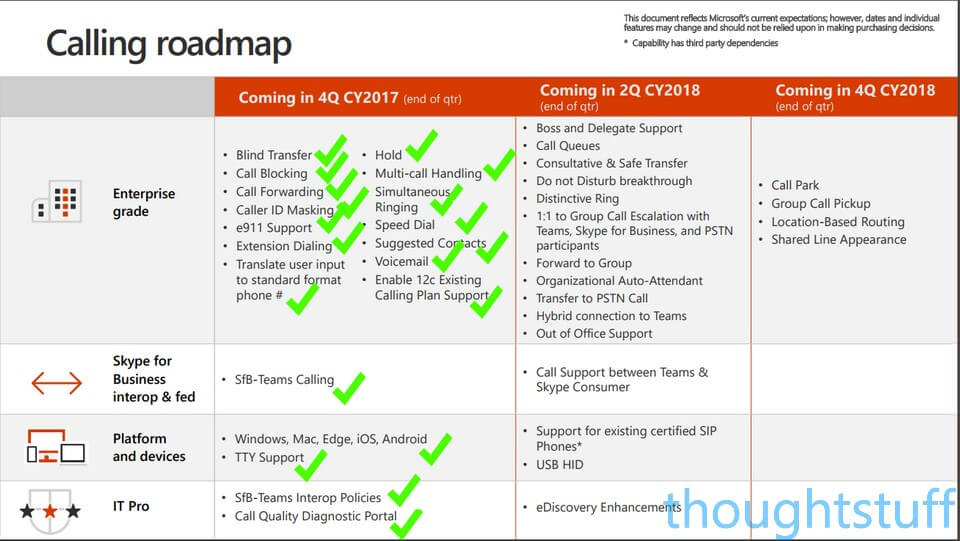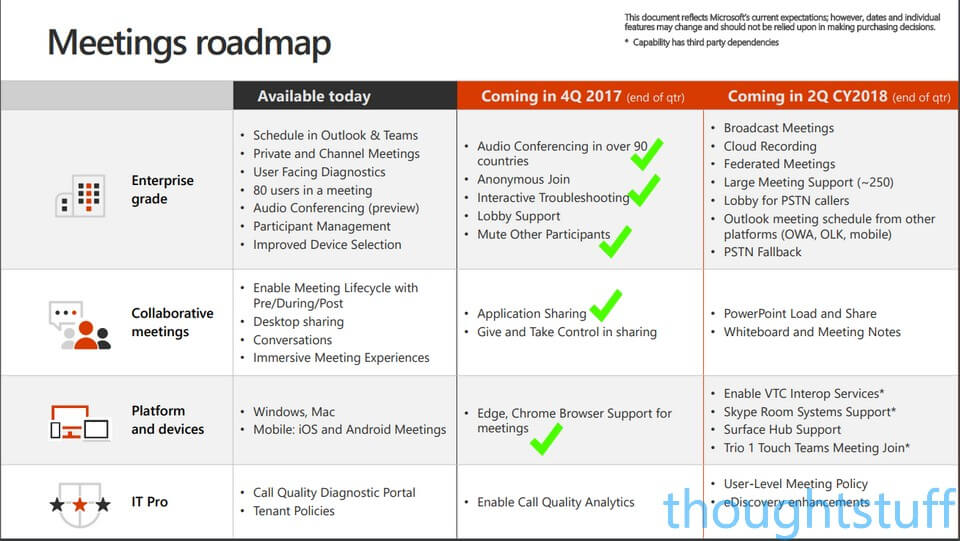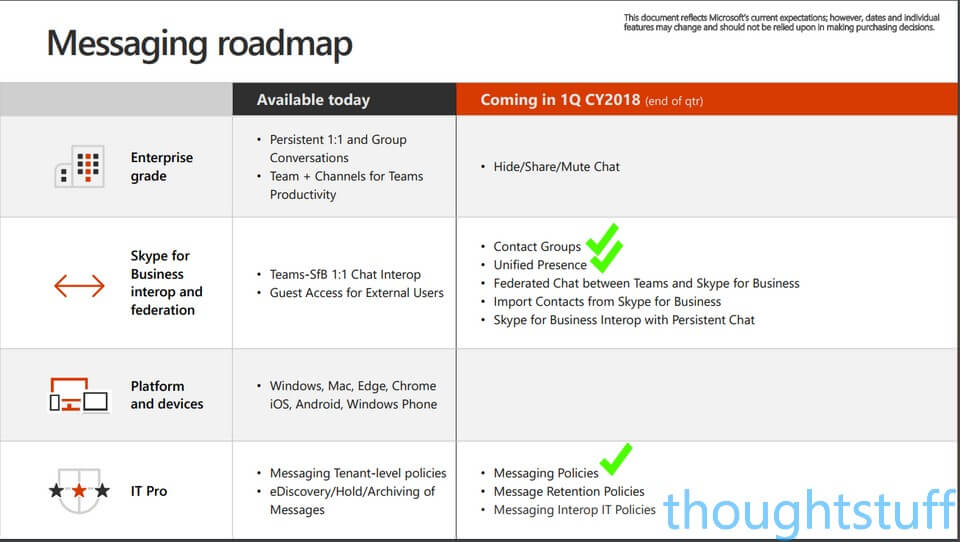Microsoft just launched 27 new features for Teams!
We knew from the publication of the Teams Roadmap in October that Microsoft had set itself some ambitious targets for delivering new features. We saw the first big features launch a few weeks ago: Teams calling.
I’ve been checking the Office 365 Roadmap regularly, tracking the rest of the features which were planned for delivery this year. In the last day or so, an amazing 27 new features have just moved to Launched status, described as Fully released updates that are now generally available for all applicable customers.
Because Microsoft Teams is delivered as an evergreen, constantly-updated web-application, rather than with defined milestone version releases, we’ll probably see these features light-up over time as they are rolled out, which means you might start to see them from the next time you open Microsoft Teams!
Here’s the full list of new features now available:
Microsoft Teams – Edge, Chrome Browser Support for meetings This is a new meeting capability coming to Teams. Support to join meetings and view screen sharing without a plug-in.
Microsoft Teams- Application Sharing This is one of the collaborative meetings capabilities coming to Teams.
Microsoft Teams – Interactive Troubleshooting This is one of the SfB meeting capabilities coming to Teams. Interactive troubleshooting refers to user-facing diagnostics to give additional advice and suggestions based upon detecting scenarios that might be impacting meeting quality. The first scenario provides the ability for attendees to detect when they are mute but are talking. Teams will let users know when that is happening and recommend going off mute so others can hear. Other scenarios will be supported as well.
Microsoft Teams – Simultaneous Ringing This is one of the SfB calling capabilities coming to Teams. This configurable feature allows for more than one phone to ring when there is an in-coming call.
Microsoft Teams – Speed dial This is one of the SfB calling capabilities coming to Teams. This features provides speed dialing to Teams users.
Microsoft Teams – Suggested Contacts This is one of the SfB messaging and calling capabilities coming to Teams. This feature will intelligently suggest contacts for you.
Microsoft Teams – Voicemail This is one of the SfB calling capabilities coming to Teams. This feature provides Voicemail with transcription and playback options.
Microsoft Teams – Translate user input to standard format phone number This is one of the SfB calling capabilities coming to Teams. Enable the automatic data normalization of user data entry.
Microsoft Teams – Call Quality Diagnostic Portal This is one of the SfB calling IT Pro capabilities coming to Teams. It provides a portal UI to allow administrators to evaluate call quality with possible corrective actions.
Microsoft Teams – TTY Support This is one of the SfB Calling capabilities coming to Teams. This feature adds TTY device Support.
Microsoft Teams – Client Support This is one of the SfB IT Pro capabilities coming to Teams. Client support for Windows, Mac, Edge, iOS and Android.
Microsoft Teams – SfB-Teams Calling This is one of the SfB calling capabilities coming to Teams. Support for Skype for Business to Teams Calling.
Microsoft Teams – Audio Conferencing in over 90 countries This is one of the SfB meeting capabilities coming to Teams. Microsoft Audio Conferencing enables attendees to Join the audio portion of a meeting by dialing a PSTN phone number and entering a conference passcode.
Microsoft Teams – Mute Other Participants This is one of the SfB meeting capabilities coming to Teams. This will enable the muting of other participants during a meeting. Especially effective for meetings with a large number of attendees.
Microsoft Teams – Contact Groups This is one of the SfB messaging capabilities coming to Teams and provides support for Contact Groups originally created in Skype for Business.
Microsoft Teams – Messaging Policies This is one of the Office 365 IT Pro capabilities coming to Teams. Administrators will be able to set user level policies to control messaging experiences in Teams.
Microsoft Teams – Unified Presence This is one of the SfB messaging capabilities coming to Teams that supports unified presence between Teams and Skype for Business.
Microsoft Teams – Teams Interop Policies This is one of the Office 365 IT Pro capabilities coming to Teams. Administrators will be able to set a wide variety of policies which govern Inter/Op between Teams and Skype for Business.
Microsoft Teams – Blind Transfer This is one of the SfB calling capabilities coming to Teams. Blind transfer allows a call to be sent to another extension immediately.
Microsoft Teams – Call Blocking This is one of the SfB calling capabilities coming to Teams. Support for Call Blocking.
Microsoft Teams – Call Forwarding This is one of the SfB calling capabilities coming to Teams. This provides support for users to configure call-forwarding for their account.
Microsoft Teams – Caller ID masking This is one of the SfB calling capabilities coming to Teams. Support for caller ID masking.
Microsoft Teams – e911 Support This is one of the SfB calling capabilities coming to Teams. Support for e911 services in Microsoft Teams.
Microsoft Teams – Extension Dialing This is one of the SfB calling capabilities coming to Teams. This feature adds support for Extension Dialing to Teams.
Microsoft Teams – Hold This is one of the SfB calling capabilities coming to Teams. This feature adds putting a call on hold and the ability to resume the call.
Microsoft Teams – Multi-call Handling This is one of the SfB calling capabilities coming to Teams. Support for the handling of multiple simultaneous calls.
Microsoft Teams – Enable Existing Calling Plan Support This is one of the SfB calling capabilities coming to Teams and enables existing calling plan support in Microsoft Teams. This still requires country level support for Calling Plan.
It’s useful to compare this list of newly-released features against the published roadmap in October. Remember that the October roadmap was just a guide, not a commitment; however, it really looks like the Teams team have knocked it out of the park and delivered on their goals. Also, some of the Q1 2018 Messaging features have made it in this month as well!



Delayed Features
There are a few features which were on the October Roadmap for delivery this year but are still showing as In Development. Some of them now have an updated estimated released date of Q1 2018. They are:
Microsoft Teams – Enable Call Quality Analytics This is one of the SfB meetings IT Pro capabilities coming to Teams and provides support for Call quality User Analytics in Microsoft Teams. Estimated Release: December CY2017 – so we’ll keep an eye on this one for the next few days!
Microsoft Teams – Lobby Support This is one of the SfB meeting capabilities coming to Teams. This feature supports delegate and lobby support for user. Estimated Release: Q1 CY2018
Microsoft Teams – Anonymous Join This is one of the SfB meeting capabilities coming to Teams. This policy controlled feature will enable anonymous users to join meetings. We also will support the lobby functionality. Estimated Release: Q1 CY2018
Microsoft Teams – Give and Take control in sharing This is one of the SfB meeting capabilities coming to Teams. Support remote desktop control via meetings in Teams. Estimated Release: Q1 CY2018
Summary
I don’t think anyone could accuse the Teams Product Team of not working hard this year! It’s a huge list of features, delivered almost entirely to a timeline set months ago. It’s a great end-of-year present for all of us using and enjoying Microsoft Teams today, and sets the scene for a really exciting 2018. Conbratulations to the entire team for this achievement! 🙂









Hard to find a feature in that post we didnt already have. Hard to make a sequel and keep calling it hard work and innovation.
Not impressed donât know why we keep acting excited about stuff we had previously under a new name.
What will they do when they run out of sfb features to port they might actually have to come up with a new feature?
Hi Tom,
thank you for this article, I’ve used it to update my SfB and Teams feature comparison table.
I add only one thing: the SfB-Teams Unified Presence works only if you use SfB Online, if the SfB account is on-prem it doesn’t work.
Regards
Luca
Congratulations!